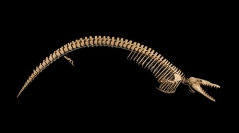

 Comptes Rendus Palevol
10 (7) - Pages 517-526
Comptes Rendus Palevol
10 (7) - Pages 517-526Cynthiacetus peruvianus nov. sp. is a new basilosaurid species, from Late Eocene to Early Oligocene Otuma Formation of Peru. It is the first described archaeocete in South-America and is represented by a sub-complete skeleton. C. peruvianus differs from C. maxwelli (middle to Late Eocene of Egypt and United States) principally in having one cuspid less on both mesial and distal sides of p3 and p4. Cynthiacetus is among the largest basilosaurids. Its more characteristic features are located on its postcranial skeleton: large vertebrarterial foramina on cervical vertebrae and absence of ventral expansion of the transverse process on C3-C5. Besides, C. peruvianus presents the greatest number of thoracic vertebrae (20) and ribs observed in Cetacea and the first thoracics have an almost vertical neural spine. A preliminary parsimony analysis establishes the monophyly of the Basilosauridae on the basis of three unambiguous cranial synapomorphies. However, within the Basilosauridae, the most diagnostic characters are observed on the postcranial skeleton.
Cetacea, Archaeocete, Basilosauridae, Late Eocene-Early Oligocene, Peru